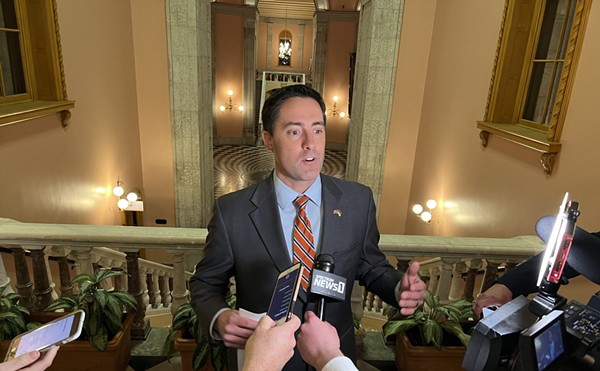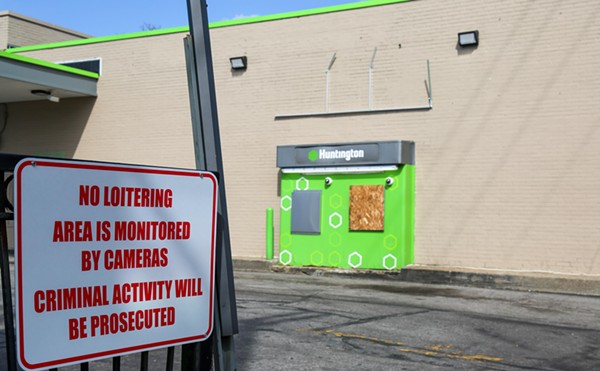They just happen to be inmates at the Cuyahoga County jail.
"Most of the people I see don't belong here," says Kellon, whose relaxed, empathetic demeanor no doubt endears him to his orange-jumpsuited patients. "Many of these people would have been in a state hospital years ago."
A nationwide effort to deinstitutionalize mental patients has unwittingly created record numbers of mentally ill people languishing in correctional facilities. Just last month, the Justice Department made official what was long a mantra of mental health advocates: Jails and prisons are the new mental institutions of our time.
At midyear 1998, the nation's prisons and jails housed more than a quarter-million mentally ill people, according to Mental Health and Treatment of Inmates and Probationers, the DOJ's first comprehensive report on the subject. Researchers found that 16 percent of jail and state prison inmates and probationers either reported a mental condition or had stayed overnight in a mental hospital or treatment program.
"People want the mentally ill locked up," says Lotus McClure, former head of the jail and prison committee of the National Alliance for the Mentally Ill's Ohio chapter. "Judges think they're doing a public service by locking them up, [but] they really don't belong in jail. They belong in a psychiatric hospital."
At the Justice Center, two floors of the county jail are reserved for the mentally ill. Those who can be stabilized with medication are scattered throughout the general population. Those deemed "transitional" are housed on the second floor, a section of which was vacated by the juvenile unit last year to make more room for mentally ill inmates.
The third floor is reserved for the most severe cases. There psychiatrists often instruct guards to take "suicide precautions" or even "homicide precautions" when dealing with the inmates, checking on them more frequently and in some cases secluding them. Patients in the most serious throes of mental crisis are sometimes strapped to a bed to restrain them.
Generally, the seriously mentally ill are of more danger to themselves than to others. During the first six months of 1999, less than half of all inmates housed on the second and third floors were charged with violent crimes. Many are in jail for drug-related or property crimes, or are brought there on minor offenses, simply because the police don't know where else to take them.
"Within the last two months, I've heard from officers in three different suburban systems," says Miriam Plax, executive director of NAMI's metro Cleveland chapter. "They don't want to press charges and put [the mentally ill] in jail, because that's not what they need."
Still, the ranks of mentally ill behind bars in Cuyahoga County continue to increase, according to Charlotte White, manager of mental health services for the county jail. According to a count taken one day last month, 12 percent of the jail's 1,860 inmates (222 people) were taking psychotropic medication.
Part of the problem can be traced to state legislation passed in 1988 that prompted state mental health facilities to send all but the most dysfunctional mentally ill to community-based care organizations. Plax says such groups are unable to keep up with the needs of people who would have been institutionalized a decade ago. "We hear from their families," Plax says. "They think [patients] are not getting the services they need."
Because state funding has not kept pace with the growing need for services, money is a major problem for Cuyahoga County's mental health providers. Although the county treats the largest population of severely mentally ill (9,977 in 1997) in the state, it allots only $8.70 per capita to mental health services. In comparison, Franklin County spends $36.50 and Montgomery County spends $30. Both counties have their own mental health levies.
"This is a hard population to sell," Plax says, explaining why there's been no organized effort to work toward a mental health levy here. "There's a tremendous stigma related to the mentally ill. They're a population that's easy to ignore."
To stay financially viable, mental health agencies must sometimes close intake and lay off staff, which inevitably leaves a number of mentally ill people to fend for themselves. "If they haven't connected with services in the community, they are obviously going to be symptomatic, and that will often translate into behavior that is unacceptable," says Helen Jones, executive director of Neighborhood Counseling Service, a mental health center.
Which often means jail. No one wants to see the mentally ill consigned to correctional facilities for relatively minor offenses, but the Cuyahoga County jail is better than most. In fact, White says, it's the number one mental health provider in the community. While only 41 percent of mentally ill inmates interviewed by the Justice Department reported receiving any treatment at all while incarcerated in jails, the county jail has set up a system for detecting and treating the mentally ill that has earned the respect and admiration of mental health advocates.
"That's the irony of the whole thing," Jones says. "The [criminal justice system] doesn't do a good job diverting people from jail, but when they get there, [it does] great. They see the cream of the crop [of psychologists and psychiatrists]."
A screening system helps identify the mentally ill when they first arrive at the county jail. They are then seen by psychiatric nurses, psychiatrists, and sometimes fellows from the prestigious University Hospitals Fellowship in Forensic Psychology program for diagnosis. In addition, mental health caseworkers act as liaisons between inmates and the courts, working to get those who are not a danger to society out of the jail as quickly as possible, and those who are in dire need of hospitalization to a state facility. When inmates are going to be freed, caseworkers attempt to link them with services in the community.
"Even with all this, the recidivism rate is pretty high," White says.
Which is not surprising. Besides being mentally ill, these inmates are often battling drug addiction, poverty, homelessness, and AIDS. Plax says that more nonviolent mentally ill offenders could be diverted into treatment by requiring additional training for law enforcement officers and establishing a "mental health court," as other cities have done.
But there's no substitute for infusing more money into the local mental health system. That might slow the parade of patients through Kellon's austere, cell-like office. It might also help change a system that sometimes makes incarceration a prerequisite for treatment.












